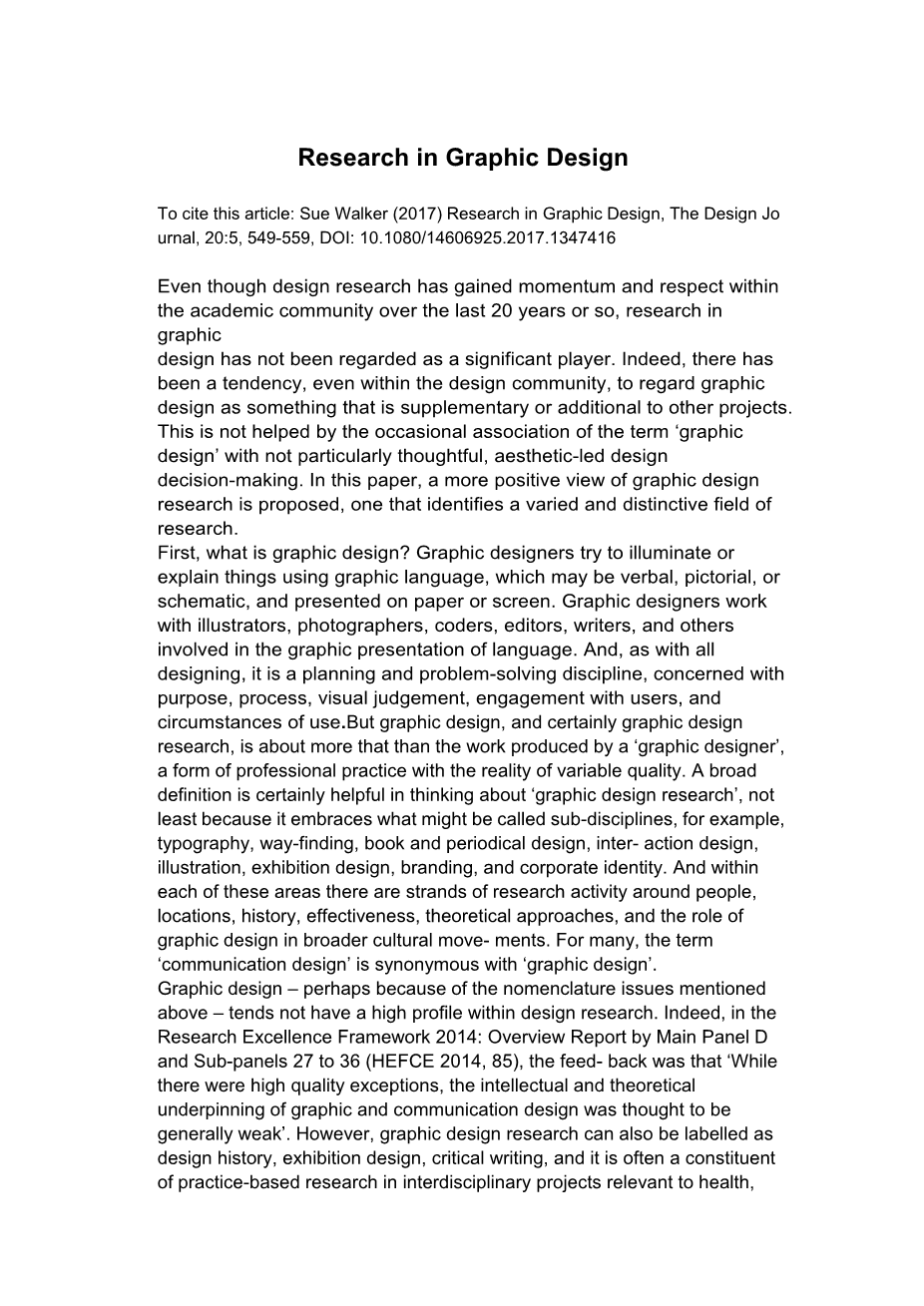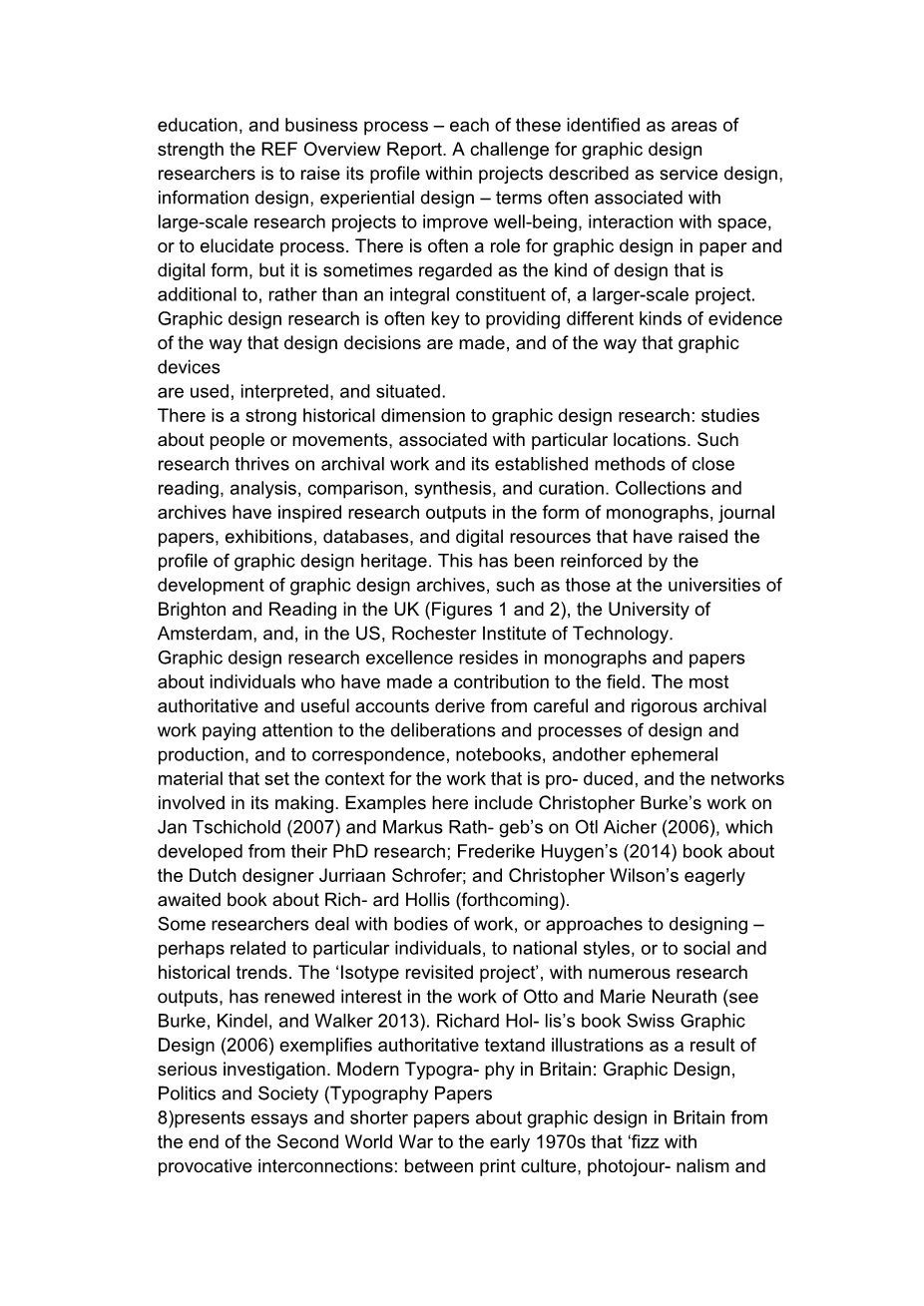

英语原文共 6 页,剩余内容已隐藏,支付完成后下载完整资料
Research in Graphic Design
Even though design research has gained momentum and respect within the academic community over the last 20 years or so, research in graphic
design has not been regarded as a significant player. Indeed, there has been a tendency, even within the design community, to regard graphic design as something that is supplementary or additional to other projects. This is not helped by the occasional association of the term lsquo;graphic designrsquo; with not particularly thoughtful, aesthetic-led design decision-making. In this paper, a more positive view of graphic design research is proposed, one that identifies a varied and distinctive field of research.
First, what is graphic design? Graphic designers try to illuminate or explain things using graphic language, which may be verbal, pictorial, or schematic, and presented on paper or screen. Graphic designers work with illustrators, photographers, coders, editors, writers, and others involved in the graphic presentation of language. And, as with all designing, it is a planning and problem-solving discipline, concerned with purpose, process, visual judgement, engagement with users, and circumstances of use.But graphic design, and certainly graphic design research, is about more that than the work produced by a lsquo;graphic designerrsquo;, a form of professional practice with the reality of variable quality. A broad definition is certainly helpful in thinking about lsquo;graphic design researchrsquo;, not least because it embraces what might be called sub-disciplines, for example, typography, way-finding, book and periodical design, inter- action design, illustration, exhibition design, branding, and corporate identity. And within each of these areas there are strands of research activity around people, locations, history, effectiveness, theoretical approaches, and the role of graphic design in broader cultural move- ments. For many, the term lsquo;communication designrsquo; is synonymous with lsquo;graphic designrsquo;.
Graphic design – perhaps because of the nomenclature issues mentioned above – tends not have a high profile within design research. Indeed, in the Research Excellence Framework 2014: Overview Report by Main Panel D and Sub-panels 27 to 36 (HEFCE 2014, 85), the feed- back was that lsquo;While there were high quality exceptions, the intellectual and theoretical underpinning of graphic and communication design was thought to be generally weakrsquo;. However, graphic design research can also be labelled as design history, exhibition design, critical writing, and it is often a constituent of practice-based research in interdisciplinary projects relevant to health, education, and business process – each of these identified as areas of strength the REF Overview Report. A challenge for graphic design researchers is to raise its profile within projects described as service design, information design, experiential design – terms often associated with large-scale research projects to improve well-being, interaction with space, or to elucidate process. There is often a role for graphic design in paper and digital form, but it is sometimes regarded as the kind of design that is additional to, rather than an integral constituent of, a larger-scale project. Graphic design research is often key to providing different kinds of evidence of the way that design decisions are made, and of the way that graphic devicesare used, interpreted, and situated.
There is a strong historical dimension to graphic design research: studies about people or movements, associated with particular locations. Such research thrives on archival work and its established methods of close reading, analysis, comparison, synthesis, and curation. Collections and archives have inspired research outputs in the form of monographs, journal papers, exhibitions, databases, and digital resources that have raised the profile of graphic design heritage. This has been reinforced by the development of graphic design archives, such as those at the universities of Brighton and Reading in the UK (Figures 1 and 2), the University of Amsterdam, and, in the US, Rochester Institute of Technology.
Graphic design research excellence resides in monographs and papers about individuals who have made a contribution to the field. The most authoritative and useful accounts derive from careful and rigorous archival work paying attention to the deliberations and processes of design and production, and to correspondence, notebooks, andother ephemeral material that set the context for the work that is pro- duced, and the networks involved in its making. Examples here include Christopher Burkersquo;s work on Jan Tschichold (2007) and Markus Rath- gebrsquo;s on Otl Aicher (2006), which developed from their PhD research; Freder
剩余内容已隐藏,支付完成后下载完整资料
资料编号:[257459],资料为PDF文档或Word文档,PDF文档可免费转换为Word


